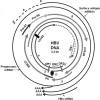Hepatitis B and C virus hepatocarcinogenesis: lessons learned and future challenges
- PMID: 21168955
- PMCID: PMC3071446
- DOI: 10.1016/j.canlet.2010.11.014
Hepatitis B and C virus hepatocarcinogenesis: lessons learned and future challenges
Abstract
Worldwide, hepatocellular carcinoma (HCC) is one of the most common cancers. It is thought that 80% of hepatocellular carcinomas are linked to chronic infections with the hepatitis B (HBV) or hepatitis C (HCV) viruses. Chronic HBV and HCV infections can alter hepatocyte physiology in similar ways and may utilize similar mechanisms to influence the development of HCC. There has been significant progress towards understanding the molecular biology of HBV and HCV and identifying the cellular signal transduction pathways that are altered by HBV and HCV infections. Although the precise molecular mechanisms that link HBV and HCV infections to the development of HCC are not entirely understood, there is considerable evidence that both inflammatory responses to infections with these viruses, and associated destruction and regeneration of hepatocytes, as well as activities of HBV- or HCV-encoded proteins, contribute to hepatocyte transformation. In this review, we summarize progress in defining mechanisms that may link HBV and HCV infections to the development of HCC, discuss the challenges of directly defining the processes that underlie HBV- and HCV-associated HCC, and describe areas that remain to be explored.
Copyright © 2010 Elsevier Ireland Ltd. All rights reserved.
Figures






References
-
- El-Serag HB, Rudolph KL. Hepatocellular carcinoma: epidemiology and molecular carcinogenesis. Gastroenterology. 2007;132:2557–2576. - PubMed
-
- Wang XW, Hussain SP, Huo T, Wu CG, Forgues M, Hofseth LJ, Brechot C, Harris CC. Molecular pathogenesis of human hepatocellular carcinoma. Toxicology. 2002;181–182:43–47. - PubMed
-
- Guidotti LG, Chisari FV. Immunobiology and pathogenesis of viral hepatitis. Annu Rev Pathol. 2006;1:23–61. - PubMed
-
- Bartosch B, Thimme R, Blum HE, Zoulim F. Hepatitis C virus-induced hepatocarcinogenesis. J Hepatol. 2009;51:810–820. - PubMed
Publication types
MeSH terms
Grants and funding
LinkOut - more resources
Full Text Sources
Medical
Molecular Biology Databases

